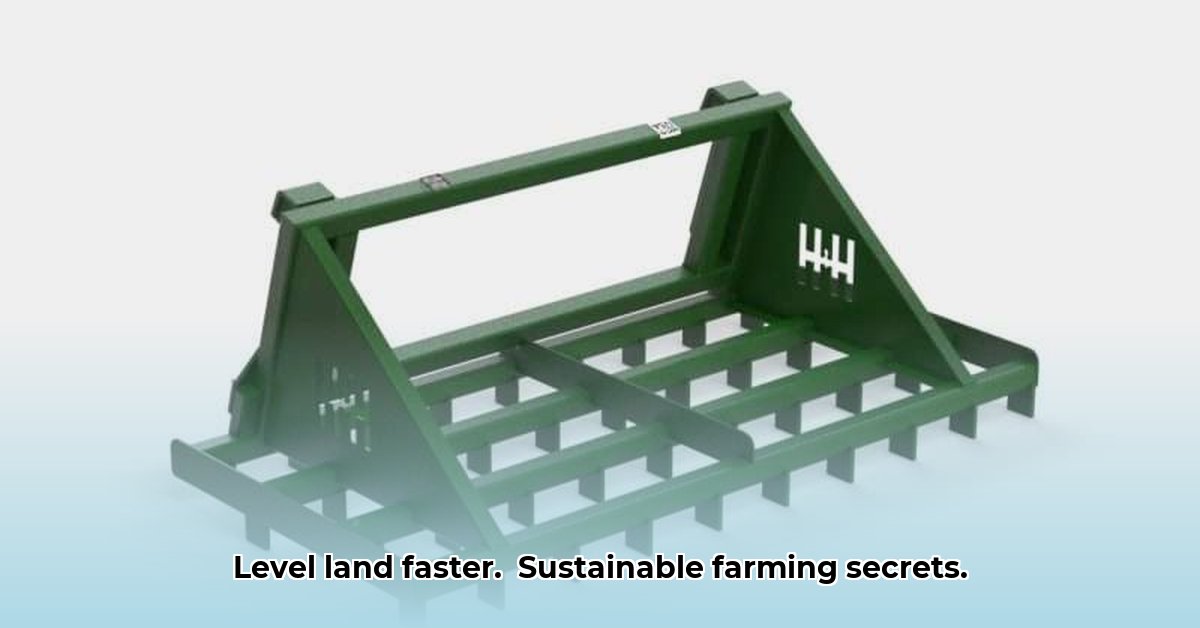
Ground Leveler for Tractor: Your Guide to Faster, Sustainable Land Prep
Uneven fields significantly impact water management, soil health, and ultimately, crop yields. This comprehensive guide details how to effectively level your land using a tractor and appropriate ground levelers, optimizing efficiency and promoting sustainable farming practices. We'll cover everything from pre-leveling assessments to long-term soil health considerations. For matching tractor size to implements, see our guide on tractor power matching.
Assessing Your Land: The Foundation of Successful Leveling
Before investing in equipment, a thorough land assessment is crucial. This is analogous to architectural blueprints before construction – neglecting this step can lead to costly mistakes. Consider these key factors:
- Soil Type: Heavier clay soils require more powerful equipment and different techniques than lighter, sandy soils. (Clay soils require a more robust approach due to their high density and tendency to stick.)
- Slope: Steeper slopes demand more powerful tractors and specialized attachments, prioritizing safety. (Steep slopes present significant safety challenges and require specialized equipment.)
- Drainage: Poor drainage can hinder crop growth and complicate leveling. Address drainage issues before leveling to prevent future problems. (Addressing drainage issues preemptively avoids potential future complications.)
- Obstacles: Rocks, tree stumps, or buried debris can damage equipment. Thorough surveying prevents costly repairs. (Pre-leveling site cleanup is often necessary to safeguard your machinery.)
This careful assessment ensures you select the correct equipment and approach, maximizing efficiency and minimizing risks. Don't you want to avoid unnecessary expenses and headaches?
Choosing the Right Equipment: Matching the Tool to the Job
Selecting the ideal ground leveler involves considering your budget, project scale, and soil type. Several options exist, each with its strengths and weaknesses:
- Box Blades: Versatile and affordable, these are ideal for smaller areas and lighter soils, offering excellent all-around performance for general grading and light leveling. They're a good starting point for many landowners.
- Scrapers: Heavy-duty and efficient for large-scale projects, scrapers move significant volumes of earth but demand more powerful tractors and represent a higher initial investment. They are perfect for large-scale earthmoving tasks.
- Land Planes: These precision tools deliver a super-smooth finish, crucial for irrigation systems and sports fields, but require expertise and represent a significant financial commitment. They are best suited for fine-leveling applications demanding high precision.
Tractor Considerations: Larger tractors offer more power but consume more fuel. Smaller tractors are fuel-efficient but may struggle with larger projects. Consider the overall project cost: fuel efficiency versus project completion time. Fuel type (diesel vs. gasoline) significantly impacts both environmental impact and cost. “Efficient leveling minimizes gravel purchases, reducing both financial and environmental costs," states Dr. Anya Sharma, Agricultural Engineer at the University of California, Davis.
The optimal choice balances cost-effectiveness, efficiency, and the specific needs of your project. What's the best balance for your unique circumstances?
Mastering the Operation: Leveling Safely and Effectively
Operating a ground leveler requires skill and caution. Prioritizing safety is paramount. Here's a structured approach:
- Pre-flight Check: Thoroughly inspect equipment before starting the tractor, ensuring all bolts are tight, components are undamaged, and safety features are functional.
- Test Run: Begin on a small, inconspicuous area to familiarize yourself with the equipment's handling and make adjustments.
- Gradual Passes: Make several overlapping passes slowly and steadily, avoiding abrupt movements that can damage equipment or create unevenness. Slow and steady wins the race here!
- Constant Monitoring: Regularly monitor progress and make adjustments to achieve the desired level.
- Safety First: Always wear appropriate safety gear, including eye protection, hearing protection, and sturdy footwear. Adhere strictly to manufacturer’s instructions.
Remember, patience is vital; rushing increases the risk of accidents and mistakes. Is safety not the most important factor in any operation?
Maintenance Matters: Keeping Your Equipment in Top Shape
Regular maintenance extends equipment lifespan and prevents costly repairs and downtime. Consider it preventative maintenance:
- Post-Use Inspection: Inspect thoroughly after each use, addressing any issues immediately.
- Cleanliness: Remove mud, dirt, and debris to prevent corrosion and ensure smooth operation.
- Lubrication: Regularly lubricate moving parts according to the manufacturer’s recommendations.
- Storage: Store in a dry, protected area to shield from elements and extend lifespan.
Proper maintenance significantly contributes to long-term cost savings and efficient operation. Do you want to minimize unexpected expenses?
Sustainability and Long-Term Effects
Proper land leveling is a sustainable practice with significant long-term environmental and economic benefits:
- Improved Water Management: Even water distribution reduces water waste and improves crop yields.
- Reduced Soil Erosion: Level ground is less susceptible to erosion, preserving valuable topsoil.
- Enhanced Soil Health: When combined with sustainable practices like cover cropping and reduced tillage (no-till farming), land leveling improves soil structure and fertility.
These effects contribute to a more sustainable farming system, reducing the need for frequent re-leveling. Does sustainable land management make good economic sense?
Case Study: Real-World Success
One farmer reported a 15% increase in crop yields following land leveling, showcasing the economic benefits of proper land preparation. This is a clear testament to the potential ROI of this approach.
Conclusion: Leveling Up Your Farming
Investing in the right equipment and mastering proper techniques is crucial for sustainable farming. This guide empowers you to confidently navigate the process of land leveling, contributing to efficient crop production and a healthier environment. Remember, continuous learning and adaptation to the latest sustainable practices are essential for long-term success.